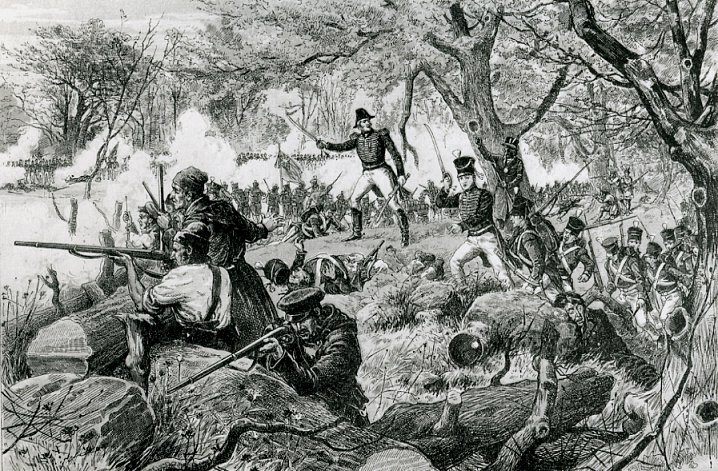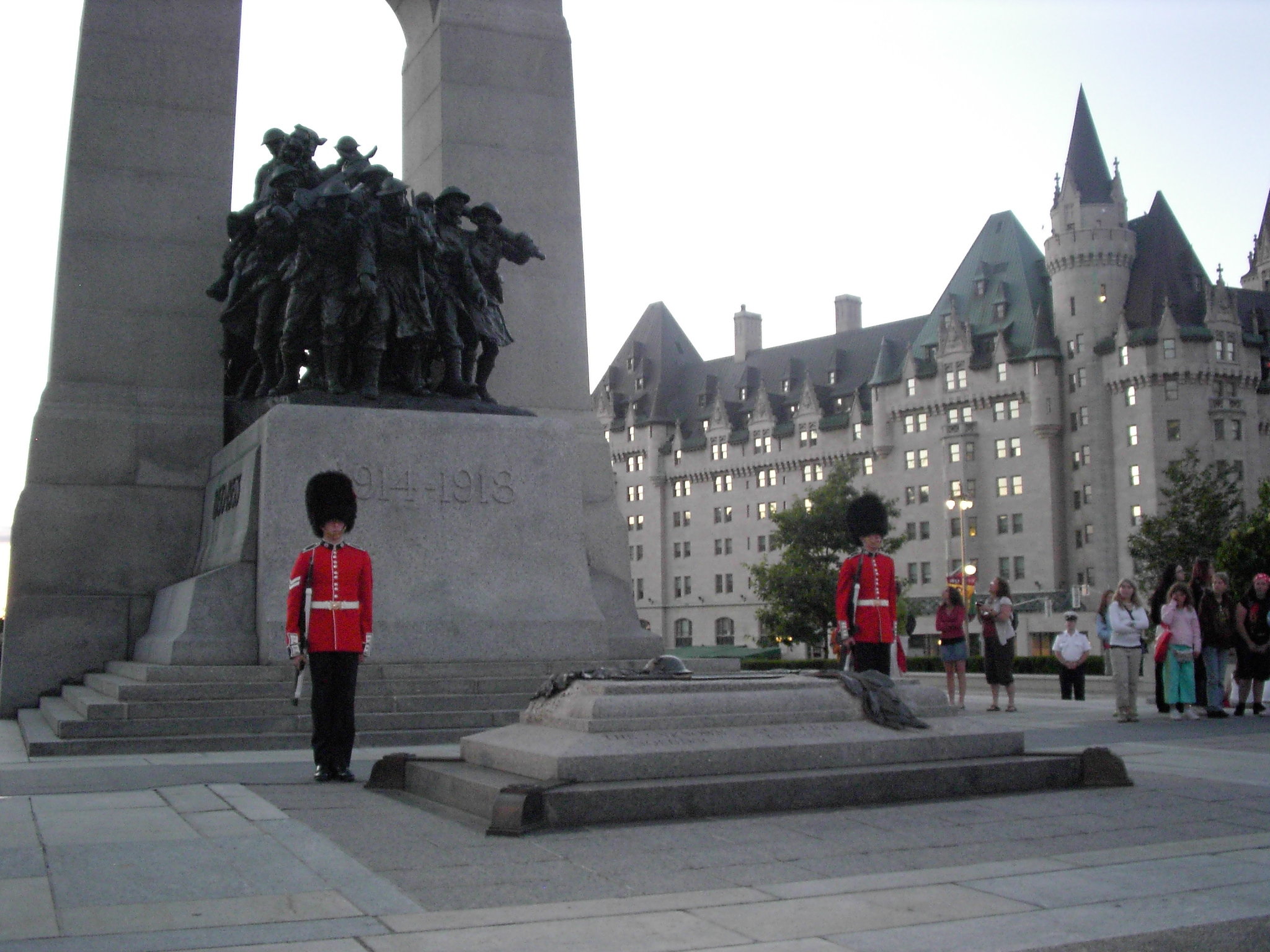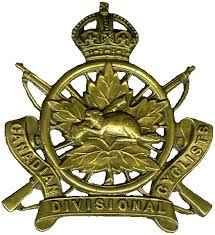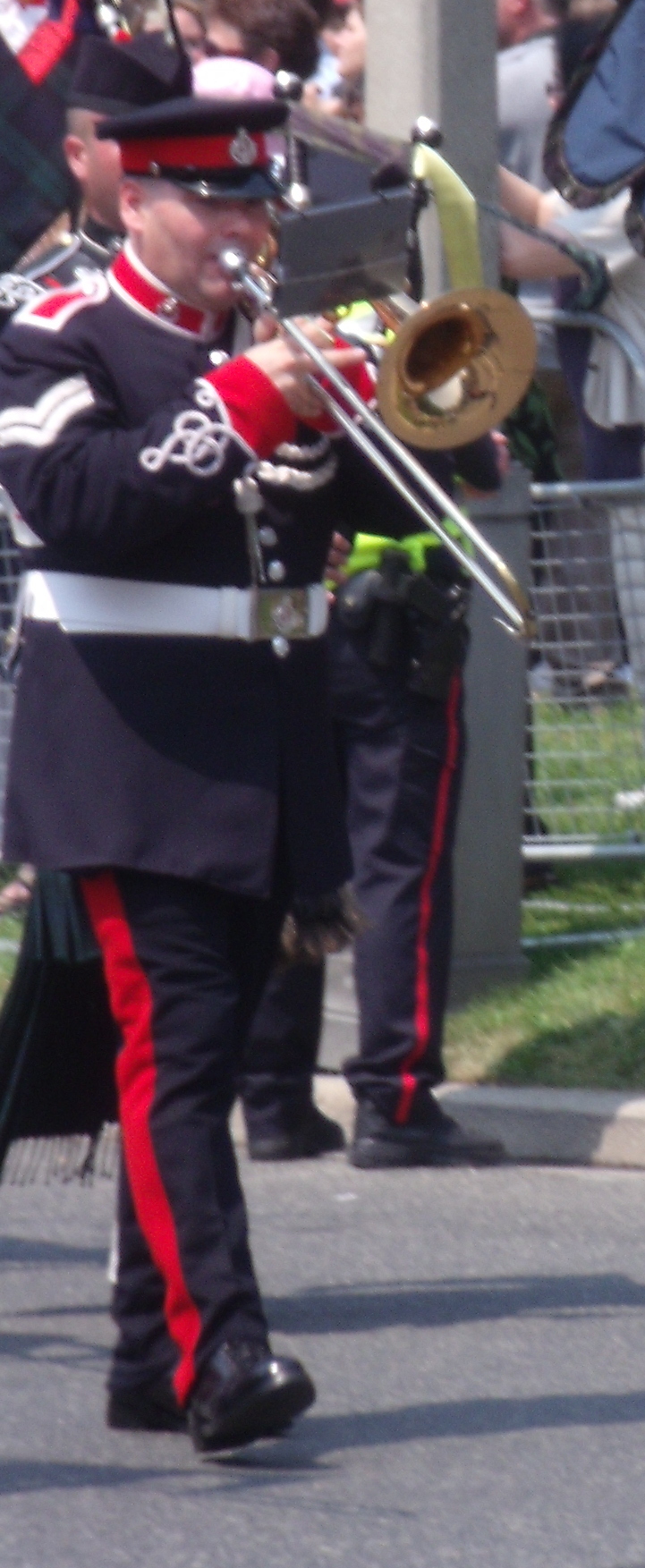|
2 Area Support Group Signal Squadron
2 Area Support Group Signal Squadron (2 ASG Sig Sqn) was a Regular Force Army unit within the Canadian Forces. The squadron was responsible for delivering secure and non-secure communication and information systems across Land Force Central Area (LFCA). The squadron's parent formation was 2 Area Support Group (2 ASG). Although an Army unit, for service delivery the squadron aligned itself to an ITIL framework for business processes and a common lexicon with industry partners. 2 ASG Signal Squadron was headquartered at Canadian Forces Base (CFB) Petawawa with platoon-sized troops in Petawawa, Kingston, Toronto, London and section-sized detachments in Ottawa, Sault Ste Marie, and North Bay. The majority of soldiers within the squadron came from the Communications and Electronics Branch. In 2013, 2 ASG Sig Sqn was renamed 4th Canadian Division Support Group Signal Squadron. History 2 ASG Sig Sqn, in various forms, has been located at CFB Petawawa since a school of si ... [...More Info...] [...Related Items...] OR: [Wikipedia] [Google] [Baidu] |
Communications And Electronics Branch
The Communications and Electronics Branch (french: Branche des communications et de l'électronique, link=no) is a personnel branch of the Canadian Armed Forces (CAF). The army component of the branch is designated the Royal Canadian Corps of Signals (french: Corps des transmissions royal du Canada, link=no). History Major Wallace Bruce Matthews Carruthers (13 February 1863 – 21 October 1910) was the founder of the Canadian Signalling Corps, forerunner of the Royal Canadian Corps of Signals and the Communications and Electronics Branch. In the 1968 unification of the Canadian Forces, functional similar components of the Royal Canadian Navy, Canadian Army and Royal Canadian Air Force were combined into the new Communications and Electronics Branch. During the Boer War, Carruthers noted the importance of tactical signaling in a successful campaign. Observing the employment of heliographs, semaphore flags and lamps, he realized there was a need for a unit to provide proper traini ... [...More Info...] [...Related Items...] OR: [Wikipedia] [Google] [Baidu] |
North Bay, Ontario
North Bay is a city in Northeastern Ontario, Canada. It is the seat of Nipissing District, and takes its name from its position on the shore of Lake Nipissing. North Bay developed as a railroad centre, and its airport was an important military location during the Cold War. History The site of North Bay is part of a historic canoe route where Samuel de Champlain took a party up the Ottawa River, through present-day Mattawa, on to Trout Lake and via the La Vase Creek to Lake Nipissing. Apart from Indigenous people, voyageurs and surveyors, there was little activity in the Lake Nipissing area until the arrival of the Canadian Pacific Railway (CPR) in 1882. That was the point where the Canada Central Railway (CCR) extension ended. The CCR was owned by Duncan McIntyre who amalgamated it with the CPR and became one of the handful of officers of the newly formed CPR. The CCR started in Brockville and extended to Pembroke. It then followed a westward route along the Ottawa Ri ... [...More Info...] [...Related Items...] OR: [Wikipedia] [Google] [Baidu] |
History Of The Canadian Army
The history of the Canadian Army, began when the title first came into official use in November 1940, during the Second World War, and is still used today. Although the official titles, Force Mobile Command, and later Land Force Command, were used from February 1968 to August 2011, "Canadian Army" continued to be unofficially used to refer to the ground forces of the Canadian Armed Forces, much as it has been from Confederation in 1867 to the present. The term was often even used in official military publications, for example in recruiting literature and the official newspaper of the Canadian Forces, ''The Maple Leaf''. On August 16, 2011, the title, "Canadian Army", was officially restored, once again bringing the official designation in line with common and historical usage. Formation Prior to Canadian Confederation in 1867, defence for the colonies that comprise present-day Canada was dependent on the armies of colonial powers. The military of New France (1608–1763) was depen ... [...More Info...] [...Related Items...] OR: [Wikipedia] [Google] [Baidu] |
Military History Of Canada
The military history of Canada comprises hundreds of years of armed actions in the territory encompassing modern Canada, and interventions by the Canadian Forces, Canadian military in conflicts and peacekeeping worldwide. For thousands of years, the area that would become Canada was the site of sporadic intertribal conflicts among Aboriginal peoples in Canada, Aboriginal peoples. Beginning in the 17th and 18th centuries, Canada was the site of French and Indian Wars, four colonial wars and two additional wars in Nova Scotia and Acadia between New France and New England; the conflicts spanned almost seventy years, as each allied with various First Nation groups. In 1763, after the final colonial war—the Seven Years' War—the British emerged victorious and the French civilians, whom the British hoped to assimilate, were declared "British Subjects". After the passing of the Quebec Act in 1774, giving the Canadians, Canadians their first charter of rights under the new regime, the B ... [...More Info...] [...Related Items...] OR: [Wikipedia] [Google] [Baidu] |
List Of Armouries In Canada
A number of armouries and drill halls exist in communities across Canada. Of these, the majority were built in Ontario and Quebec. Architecture Chief Dominion Architects The Chief Dominion Architect(s) designed a number of prominent public buildings in Canada including armouries, drill halls, post offices, and Dominion Public Buildings : Thomas Seaton Scott (1871–1881); Thomas Fuller (1881–1897); David Ewart (1897–1914); Edgar Lewis Horwood (1914–1918); Richard Cotsman Wright (1918–1927); Thomas W. Fuller (1927–1936), Charles D. Sutherland (1936–1947); Joseph Charles Gustave Brault (1947–1952) Thomas Seaton Scott, Thomas Fuller and Thomas W. Fuller adopted the ''Dominion Style'' Neo-Gothic style. David Ewart embraced the Baronial style. The armouries may display Gothic Revival (1740s+), Tudorbethan (1835–1885+), Romanesque Revival (1840–1930); Colonial Revival (1890s+); Châteauesque (1887–1930) or Edwardian Baroque 1901-1922 style. Drawings for v ... [...More Info...] [...Related Items...] OR: [Wikipedia] [Google] [Baidu] |
2 Military Police Regiment (Canada)
2 Military Police Regiment (2 MP Regt; french: links=no, 2e Régiment de la Police Militaire) is a unit of the Canadian Forces. It provides support to the Canadian Army within the Province of Ontario. It does not provide support to Canadian Forces Bases Borden, Trenton and North Bay and Canadian Forces Support Unit (Ottawa). The unit was initially created in the summer of 2006. Since then, the unit was officially established by a ministerial organization order (MOO) and a Canadian Forces organization order (CFOO) dated September 24, 2007. It is a "total force" unit of the Canadian Army Military Police Group (CA MP Gp). The term ''total force'' describes a unit which includes both Regular Force and Reserve Force members. 2 MP Regt is responsible for police, security and detention operations as well as police support in field operations. The unit headquarters is located at the George Taylor Denison III Armoury, more commonly known as Denison Armoury, i ... [...More Info...] [...Related Items...] OR: [Wikipedia] [Google] [Baidu] |
32 Combat Engineer Regiment
32 Combat Engineer Regiment (32 CER) is the Primary Reserve unit of the Royal Canadian Engineers in Toronto, Ontario, Canada. It is assigned to 32 Canadian Brigade Group, part of 4th Canadian Division. The unit parades Friday evenings at the Denison Armoury. It was formerly known as the 2nd Field Engineer Regiment (2 FER) before being renamed in 2006. Unit history Militia Order No. 1 dated 14 January 1876 authorized the formation of the Toronto Engineer Company. This name was changed in October of the same year to the 2nd Military District Engineer Company, although it continued to be known by the original name. The establishment of the company called for two officers and 39 other ranks, however at the time of formation the actual strength was five officers and seventy other ranks which included a band of 18. The company's first commanding officer was Lieutenant Colonel Thomas Clarkson Scoble. With no established engineer stores and no trained instructors, his problems were num ... [...More Info...] [...Related Items...] OR: [Wikipedia] [Google] [Baidu] |
2 Intelligence Company
2 Intelligence Company (abbreviated 2 Int Coy) is a Canadian Armed Forces Primary Reserve Intelligence Branch unit based in Toronto, headquartered at Denison Armoury. It is part of the 4th Canadian Division. The Intelligence Officers and Operators of the unit reside in the Greater Toronto Area, work as professionals in the business community and are also active in numerous community service organizations. They deploy on domestic and foreign operations, and are primarily responsible for tactical, or combat intelligence. Recent deployments include to Cyprus, Bosnia, Afghanistan, Kuwait, and Canada. Lineage 2 Intelligence Company perpetuates the presence of a military intelligence unit in Toronto that can be traced back to the original No. 2 Guides Company that was formed April 1, 1903. As mounted units, Guides Companies were tasked to survey their respective regions as well as to collect information of potential military intelligence value. Upon mobilization for World War I, G ... [...More Info...] [...Related Items...] OR: [Wikipedia] [Google] [Baidu] |
The Governor General's Horse Guards
The Governor General's Horse Guards is an armoured reconnaissance regiment in the Primary Reserve of the Canadian Army. The regiment is part of 4th Canadian Division's 32 Canadian Brigade Group and is based in Toronto, Ontario. It is the most senior reserve regiment in Canada, and the only household cavalry regiment of Canada's three household units. Structure The regiment maintains a traditional structure, with squadrons and units for deployment and active duty, training, ceremony, cadets, and administration. Regimental Headquarters Regimental Headquarters (RHQ) consists of the command team to include the commanding officer, the regimental sergeant major, the second in command, the padre, adjutant and drill sergeant. RHQ also consists of the Operations and Training Cell, which includes an operations officer, warrant officer, training officer and sergeant. The Training Cell oversees the recruits and their progress and interacts with the Battle School with instructor cadre. The ... [...More Info...] [...Related Items...] OR: [Wikipedia] [Google] [Baidu] |
32 Canadian Brigade Group
32 Canadian Brigade Group (32CBG) of the Canadian Army is part of the 4th Canadian Division. It is centred on the Greater Toronto Area, as well as Niagara Region and Brantford. It is headquartered at LCol George Taylor Denison III Armoury in Toronto, Ontario. Brigade Command Colonel Daniel Stepaniuk, CD, is the Commander of 32 CBG whilst Chief Warrant Officer David Turnbull, CD, is the Brigade Sergeant-Major. Brigade Headquarters has a staff of approximately 40 full-time and 20 part-time members, both military ( Regular and Reserve) and civilian. History Second World War 32nd (Reserve) Brigade Group was created, within 2 Militia District, on 1 April 1942 when the reserve force in Canada was reorganized for the war. Like today, the formation consisted of part-time soldiers who paraded and trained on evenings and weekends. The brigade group was closed down on 30 January 1946 and the headquarters itself closed on 2 April 1946. During its existence, the brigade group was headq ... [...More Info...] [...Related Items...] OR: [Wikipedia] [Google] [Baidu] |
Ontario
Ontario ( ; ) is one of the thirteen provinces and territories of Canada.Ontario is located in the geographic eastern half of Canada, but it has historically and politically been considered to be part of Central Canada. Located in Central Canada, it is Canada's most populous province, with 38.3 percent of the country's population, and is the second-largest province by total area (after Quebec). Ontario is Canada's fourth-largest jurisdiction in total area when the territories of the Northwest Territories and Nunavut are included. It is home to the nation's capital city, Ottawa, and the nation's most populous city, Toronto, which is Ontario's provincial capital. Ontario is bordered by the province of Manitoba to the west, Hudson Bay and James Bay to the north, and Quebec to the east and northeast, and to the south by the U.S. states of (from west to east) Minnesota, Michigan, Ohio, Pennsylvania, and New York. Almost all of Ontario's border with the United States f ... [...More Info...] [...Related Items...] OR: [Wikipedia] [Google] [Baidu] |
Order Of Military Merit (Canada)
"Service before self" , eligibility = Standing membership in the Canadian Forces , criteria = Conspicuous merit and exceptional service , status = Currently constituted , head_title = Sovereign , head = Charles III , head2_title = Chancellor , head2 = Governor general of Canada , head3_title = Principal Commander , head3 = Chief of the Defence Staff , grades = , established = 1 July 1972 , founder = Elizabeth II , first_induction = , last_induction = , total = 5,285 , recipients = , individual = , higher = Dependent on grade , lower = Dependent on grade , image2 = , caption2 = The Order of Military Merit (french: Ordre du mérite militaire) is a military honour for merit that is, within the Canadian system of honours, the second highest order administered by the governor in Council, on behalf of the Canadian ... [...More Info...] [...Related Items...] OR: [Wikipedia] [Google] [Baidu] |





